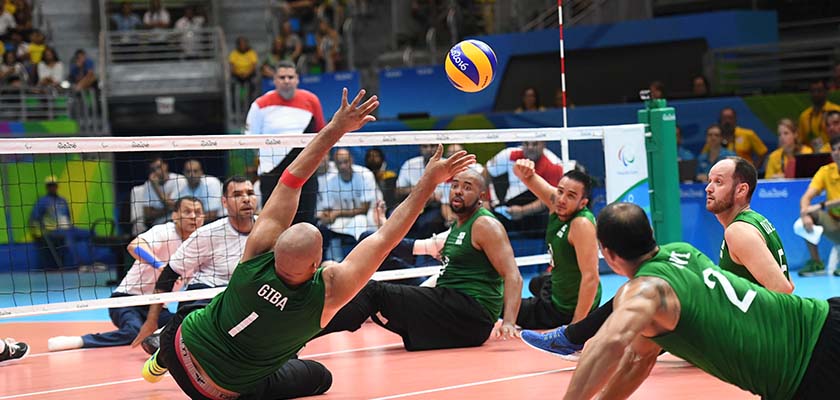Sitting volleyball (also called paralympic volleyball) is a sport adapted to allow the inclusion of physically disabled athletes. Thus, the sitting volleyball rules are an adaptation of conventional volleyball, with some modifications. Check out everything you need to know!
Participate in our free WhatsApp community and receive daily tips, news and trivia from over 50 sports! Click here to join.
Sitting volleyball rules: scoring
The score in sitting volleyball is determined by the rally point system, which means that a point is scored every time the ball is played, regardless of which team served.
The matches are played in best of five sets. Each set is played until one of the teams reaches 25 points, with a minimum difference of two points. If there is a tie at 24 points, the set continues until one team has a two-point lead.

If the match is extended to a fifth (deciding) set, this set is usually played until one team reaches 15 points, again with a minimum difference of two points.
The team that wins three sets first (or two sets in the case of shorter competitions) is declared the winner of the match.
If a team commits a fault or an error, the opposing team wins a point. This can include a ball that touches the opponent’s court, a ball that goes out, a service fault, among others.
Score per ace
An “ace” is scored when a player serves the ball and it lands in the opponent’s court without being touched by the other team’s players. In this case, the serving team wins a point.
Another rule of sitting volleyball is that the teams switch sides of the court every time the sum of the teams’ points reaches a multiple of seven (7, 14, 21, etc.), except in the fifth set, where the switch occurs when the first team reaches 8 points.
Sitting volleyball rules: positioning
In sitting volleyball, players must remain in contact with the floor at all times during the game. This means that they cannot get up or move from their sitting position while the ball is in play.
The service in sitting volleyball can be performed in a similar way to traditional volleyball, but the player must remain seated during the serve. The serve can be executed with one hand or both, as long as the player remains seated.
The blocking in sitting volleyball is a little different from traditional volleyball due to the players’ sitting position: the blockers must remain seated and can use their hands and arms to block the ball, but they cannot lift or touch the net. We’ll talk about fouls in more detail later.
As far as substitutions in sitting volleyball are concerned, the rules are similar to those of traditional volleyball, but there may be some adaptations to accommodate the needs of seated players, such as limitations on the number of times a player can be substituted during a set.

Sitting volleyball rules: fouls
Some actions are considered faults in sitting volleyball and result in points being awarded to the opposing team.
The most obvious is that a player may not touch the net during play. This includes touching the net with their hands, body or any part of their uniform. If a player touches the net during play, it is considered a foul and the opposing team is awarded a point.
Athletes are also not allowed to invade the net space or cross the center line while the ball is in play. If a player encroaches on the center line, it is considered a foul and the opposing team wins a point.
Touches on the ball
The team can only touch the ball up to three times before sending it back to the opposing side. If the team touches the ball four times or more before sending it back, it is considered a foul and the opposing team wins a point.
During a play, a player can only touch the ball once in a row, except when blocking. If a player touches the ball twice in a row (except when blocking), it is considered a foul and the opposing team wins a point.
The aim of sitting volleyball
The objective of sitting volleyball is to keep the ball in play and make it touch the ground on the opponent’s side of the court. At the same time, it is necessary to prevent the ball from touching the floor. Players compete in teams to pass the ball, serve, attack, block and defend.
Sitting volleyball: curiosities
- It emerged in Holland in the 1950s as a therapy for wounded soldiers.
- It became an official Paralympic sport in 1980.
- It is played by athletes with various physical disabilities, from paraplegia to amputations.
- It has an adapted court and the use of antennas to define the playing area.
- It has experienced global growth with international and national competitions.
- It’s played with teams of six players on each side of the court.
- Its main purpose is to promote inclusion and equality.
- The Brazilian women’s sitting volleyball team won in 2022.
Now that you know all about the rules of sitting volleyball and can consider yourself a true expert on the subject, follow our other content:





